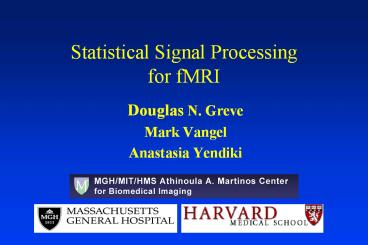Statistical Signal Processing for fMRI - PowerPoint PPT Presentation
Title:
Statistical Signal Processing for fMRI
Description:
Preprocessing 'Univariate' First-Level GLM Analysis 'Univariate' Higher-Level GLM Analysis ' ... Preprocessing. k-Space reconstruction. Slice-Timing Correction ... – PowerPoint PPT presentation
Number of Views:269
Avg rating:3.0/5.0
Title: Statistical Signal Processing for fMRI
1
Statistical Signal Processing for fMRI
- Douglas N. Greve
- Mark Vangel
- Anastasia Yendiki
2
Overview
- First-Level Univariate Analysis
- Signal Modeling
- Nuisance Modeling
- Noise Modeling
- Hypothesis Testing
- Correction for Multiple Comparisons
- Cross-Subject/Higher Level Analysis
- Lab
3
Analysis Goals
- Quantify Neural Correlates in fMRI
- Amplitude of Hemodynamic Response
- Delay/Shape of Hemodynamic Response
- Extent/Size of Activation
- Localization of function
- Quantify Uncertainty
- Cross-subject (within group)
- Cross-group eg, Normals, Clinical Populations
- Within-subject EEG/MEG/Optical/Surgical
Planning
4
Challenges
- Large Noise thermal, physiological, motion
- Small Signal delay, dispersion
- Structural/Functional Alignment within subject
- Intersubject Alignment
- Copious amounts of data eg, 20 subjects, 5 runs
per subject, 100 time points per run, 64x64x30
volume 1.2G data points - More spatial voxels than time points (multiple
comparisons problem). - Model Validation
5
Method
- Correlational synchronized stimulus and
acquistion - Linear/Gaussian Assumptions
- GLM General Linear Model
- MSE Minimum Square Error
- LMS Least Mean Squares
- Massively Univariate
6
Hemodynamic Response (BOLD)
TR (2sec)
Equilibrium (16-32sec)
Delay (1-2sec)
7
fMRI Noise
Synthetic data.
8
Averaging
Synthetic data.
9
Typical Analysis Stream
- Preprocessing
- Univariate First-Level GLM Analysis
- Univariate Higher-Level GLM Analysis
- Multivariate Analysis
- Packages
- SPM Statistical Parametric Mapping
- AFNI Analysis of Functional NeuroImages
- FSL fMRI Software Library
- FS-FAST FreeSurfer Functional Analysis STream
10
Preprocessing
- k-Space reconstruction
- Slice-Timing Correction (?)
- Motion Correction
- Spatial Filtering (Smoothing - FWHM)
- Intensity Normalization
- Temporal Filtering (or in analysis)
- Per-run, within subject
11
Univariate First-Level Analysis
- Per-voxel, per-subject
- Postulate model of the observable (ie raw time
course) - Signal model (eg, hemodynamic response)
- Noise model (eg, autocorrelation function)
- Drift (eg, mean offset, linear, quadratic)
- General Linear Model (GLM)
- Parameterized
- Linear (superposition)
- Least-mean-square estimation of parameters
- Hypothesis Test Contrast of Parameters
- Assemble into a map
12
Univariate High-level Analysis
- Per-voxel, Cross-subject
- Requires intersubject registration
- Dave Kennedy
- Uses information from First/Lower Levels
- GLM to describe relationship
- Random Effects
- Fixed Effects
13
Multivariate Statistics
- Cross-voxel (within map)
- Thresholding and multiple comparisons problem
- Gaussian Random Fields (GRF)
- Principal Component Analysis (PCA/SVD)
- Independent Component Analysis
- Region-of-Interest
14
(No Transcript)
15
Hemodynamic Response Model
TR (2sec)
Equilibrium (16-32sec)
Delay (1-2sec)
16
Visual Activation Paradigm
Flickering Checkerboard
Visual, Auditory, Motor, Tactile, Pain,
Perceptual, Recognition, Memory, Emotion,
Reward/Punishment, Olfactory, Taste, Gastral,
Gambling, Economic, Acupuncture, Meditation, The
Pepsi Challenge,
- Scientific
- Clinical
- Pharmaceutical
17
Blood Oxygen Level Dependence (BOLD)
Neurons
Deoxygenated Hemoglobin (ParaMagnetic)
Oxygenated Hemoglobin (DiaMagnetic)
Lungs
Oxygen
CO2
18
Functional MRI (fMRI)
Sample BOLD response in 4D Space (3D) voxels
(64x64x35, 3x3x5mm3) Time (1D) time points
(100, 2 sec)
Time 3
Time 1
Time 2
19
Analysis Goals
- Given
- raw fMRI time course and
- stimulus presentation times
- Compute
- Hemodynamic Response (HRF) Amplitude
- HRF Confidence Interval
- P-Value
- Noise Amplitude
Quantify Uncertainty
20
Final Results Maps
- Assign values to each voxel
- Display as pseudo-color images
- Threshold?
21
Final Results Tables
- List of active regions
Cluster Number TalX (mm) TalY (mm) TalZ (mm) Volume (mm3) Sig (log10)
1 -30.5 13.2 0.2 125.6 5.7
2 4.5 9.7 -20.2 878.1 4.1
3 2.9 -18.0 17.7 400.3 3.2
22
Final Results Waveforms
- Average raw data over time and space































